Ever wonder how to make a tiny bedroom feel spacious, cozy, and totally functional? Small bedroom design ideas have become incredibly popular because more people are living in urban settings or simply want to maximize their limited space without sacrificing style or comfort. Clever furniture choices, smart storage solutions, and visual tricks can transform even the tiniest rooms into relaxing retreats that don’t feel cramped or cluttered.
In this article, you’ll find a treasure trove of inspiration and practical tips to optimize your small bedroom. From multi-purpose furniture and vertical storage to clever layout hacks and decorative touches, these ideas are designed to help you create a space that’s both beautiful and highly functional. Whether you’re looking for quick upgrades or full-room makeovers, get ready to discover creative ways to turn your small bedroom into a chic, comfortable haven.
1. Multi-Functional Furniture: Beds with Built-In Storage Solutions
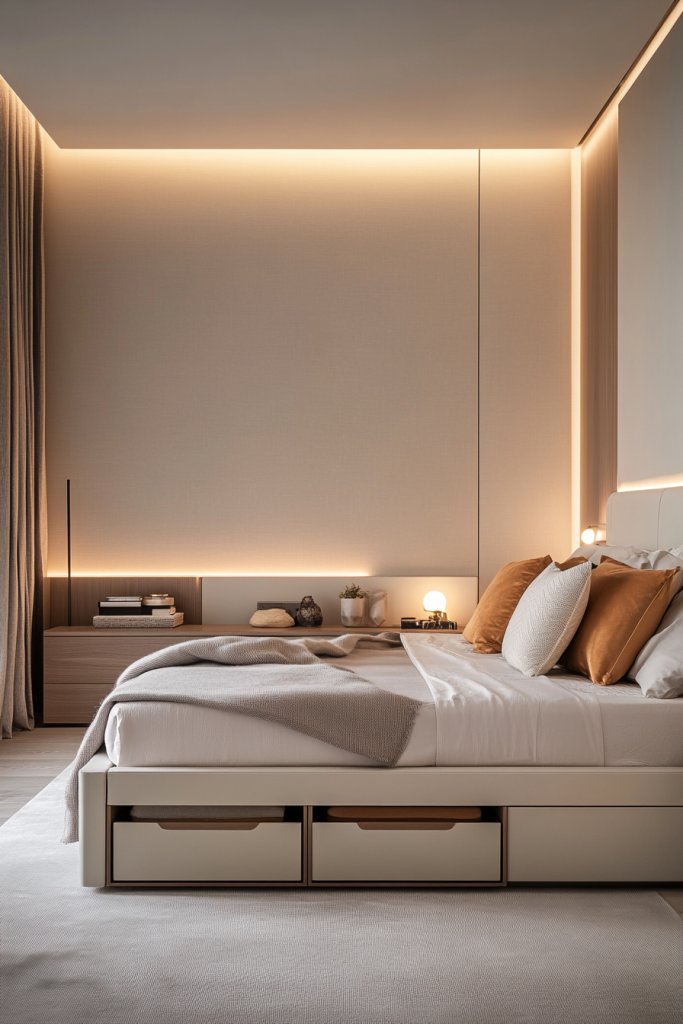
Maximize your small bedroom’s potential by choosing beds that double as storage spaces. These clever pieces of furniture help eliminate clutter while providing a sleek, streamlined look, making your room feel larger and more organized.
Picture a modern platform bed with drawers neatly tucked underneath, finished in a soft matte white or warm wood tone. Some beds feature headboards with built-in shelves or compartments, perfect for storing books, accessories, or cozy throw blankets.
The surfaces are smooth, with plush mattresses topped by inviting textiles like a textured linen duvet and fluffy pillows. The overall scene feels uncluttered yet cozy, with hidden storage seamlessly blending into the design, creating a calm, inviting space that encourages relaxation.
To implement this idea, start by selecting a bed frame with integrated storage options—many furniture stores offer models with drawers or lift-up mechanisms. If you prefer an easy DIY upgrade, opt for a standard platform bed and add storage bins or rolling drawers underneath.
Consider finishing materials like laminate, plywood, or reclaimed wood for a sustainable, budget-friendly approach. Ensure the storage space is accessible and safe, especially if you have young children or pets. With just a few tools and some organization baskets, you can transform your small bedroom into a clutter-free sanctuary.
2. Vertical Wall Storage: Maximizing Space with Shelves and Cabinets
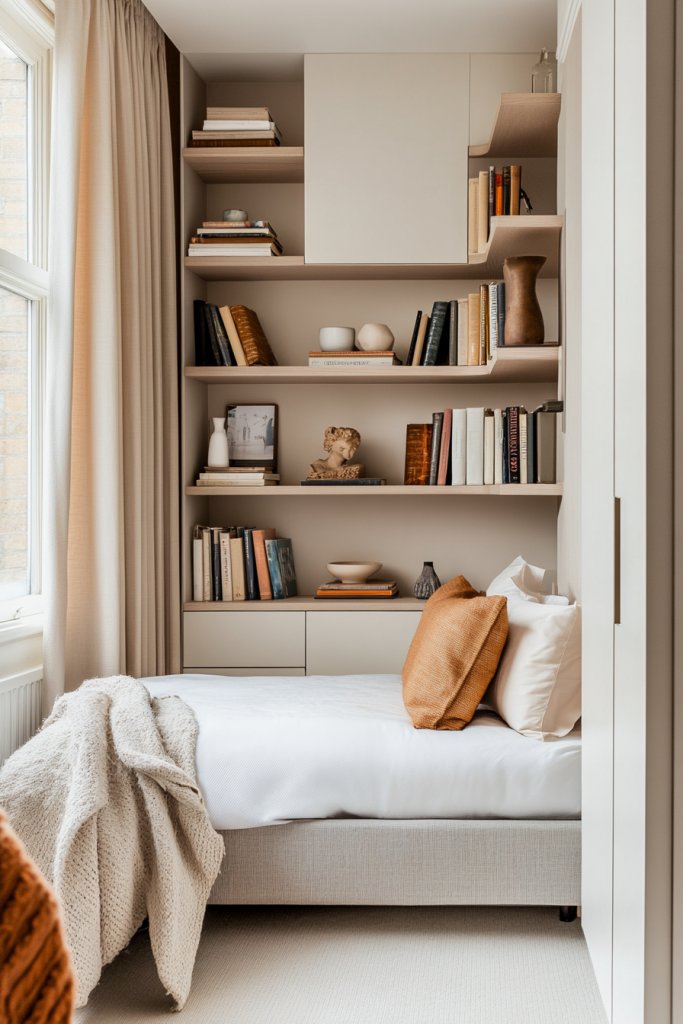
In tiny bedrooms, vertical wall storage is a game-changer, offering ample space for essentials and decorative touches without sacrificing floor area. Installing shelves and cabinets up high helps you keep belongings organized and the room feeling open.
Imagine sleek, floating white shelves lining the wall above your bed or beside your closet, holding everything from books to decorative ceramics in shades of soft gray, blush pink, or deep navy. You might add a small wall-mounted cabinet with frosted glass doors for hidden storage, creating a tidy look.
The wall surfaces are clean and uncluttered, with textured textiles like a cozy throw or a woven wall hanging adding warmth. The overall vibe is airy, functional, and minimal, with the visual focus on well-placed storage that maximizes every inch.
To create this setup, start with simple floating shelves made of wood or MDF, secured with sturdy wall anchors. Choose wall-mounted cabinets for closed storage—make sure they’re installed at accessible heights.
Use decorative bins or baskets on open shelves to organize smaller items. For safety, ensure all fixtures are securely anchored into studs or drywall anchors. This approach is beginner-friendly and highly customizable, so you can grow your storage system as your needs evolve.
3. Lofted Beds for Increased Floor Space and Privacy
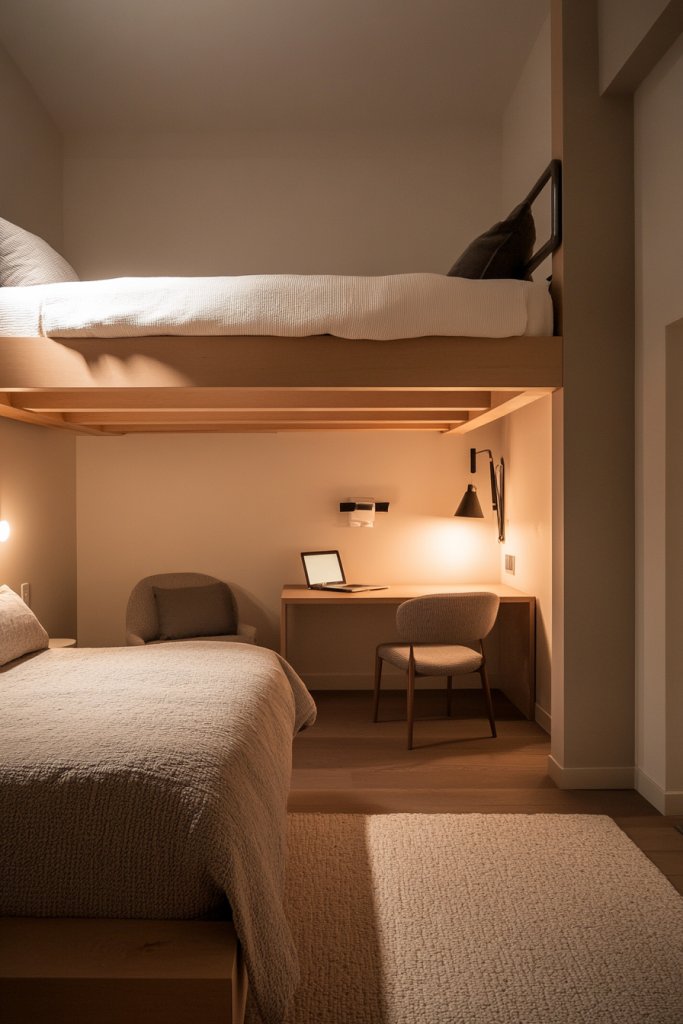
Lofted beds are a fantastic solution for small bedrooms, elevating your sleeping area to create additional usable space beneath. This design not only adds a sense of privacy but also opens up the room for other functions like a workspace or seating area.
Visualize a sturdy, wooden loft bed painted in a crisp white or natural finish, with a cozy mattress topped by a soft, neutral-colored duvet and a few textured pillows. Underneath, you might set up a compact desk, a small sitting nook with a plush armchair, or even a mini wardrobe.
The elevated bed leaves the floor free, making your space feel less crowded and more versatile. The overall effect is a clever blend of comfort and practicality, with the room feeling more spacious and organized.
To implement, choose a ready-made loft bed or build your own using simple framing materials like pine or engineered wood. Ensure the structure is sturdy and includes safety rails.
For a customizable touch, add a cozy curtain or fabric panel around the bed for privacy. Incorporate a small ladder or stairs that are easy to access, and consider adding storage pockets or hanging organizers on the bed frame for added convenience. With a little planning, loft beds can transform even the smallest bedroom into a multi-functional retreat.
4. Compact Nightstands with Hidden Compartments

A small bedroom doesn’t mean sacrificing storage—compact nightstands with hidden compartments cleverly combine function and style. These pieces keep your essentials close at hand while maintaining a tidy look.
Picture a sleek, minimalist nightstand in matte black or warm wood, featuring a drawer that slides out smoothly with a secret compartment inside. The surface holds a small lamp with a textured lampshade, a ceramic mug, and a cozy candle.
The drawer’s interior can store chargers, books, or personal items, keeping clutter out of sight. The clean lines and muted tones give the space a modern, calming feel, with hidden storage adding a touch of surprise and practicality.
To create your own, look for small bedside tables that have concealed compartments or multiple layers. Alternatively, repurpose a vintage trunk or a small storage ottoman with a hinged lid.
Use organizer trays or small baskets inside the compartments for easy access. Focus on materials like veneered wood, MDF, or metal for durability and style. This simple upgrade helps keep your nighttime essentials organized and your room looking streamlined.
5. Foldable and Murphy Beds for Flexible Room Use

Foldable and Murphy beds are perfect for small bedrooms that serve multiple purposes, allowing you to switch seamlessly between sleeping and living or working spaces. These beds fold away when not in use, freeing up precious floor space.
Imagine a Murphy bed hidden behind a stylish wall panel or a fold-down bed with a sleek, modern frame in a neutral palette. When folded up, the room transforms into a cozy living area with a small sofa or desk.
During the night, the bed drops down smoothly, with a plush mattress topped by a soft duvet and decorative pillows. The room feels spacious during the day and cozy at night, with the flexibility to adapt to your needs.
To implement, choose a Murphy bed kit or hire a professional for custom installation. For DIY, consider a wall-mounted foldable bed with sturdy brackets and a quality mattress.
Use a wall panel or cabinet to conceal the bed when folded, often in finishes like white, gray, or natural wood. For added comfort, invest in a good-quality foam or innerspring mattress. This versatile solution makes the most of limited space, perfect for small bedrooms that need to function as multi-use areas.
6. Under-Bed Drawers and Storage Bins for Clutter-Free Living

Maximizing every inch of a small bedroom means cleverly utilizing hidden spaces for storage, and the space under your bed is a goldmine. This idea transforms what’s often wasted space into a tidy sanctuary, helping keep your room clutter-free and visually calm.
Imagine sliding out sleek under-bed drawers in soft neutral hues like blush pink or charcoal gray, made from smooth wood or durable plastic. Alternatively, storage bins with fabric or woven exteriors sit neatly beneath, their lids securely hiding seasonal clothes, shoes, or extra bedding.
The bed itself remains a cozy centerpiece, but now it doubles as a practical storage hub. The space feels more open, with a sense of order that’s almost refreshing, and the scent of fresh linen or a hint of lavender from nearby sachets can enhance the calm ambiance.
To implement, start by measuring the clearance under your bed frame to choose appropriately sized drawers or bins. Opt for rolling plastic containers with handles for easy access or fabric storage bags that slide smoothly.
Place some non-slip mats or felt pads underneath to prevent noise and shifting. For a DIY touch, repurpose wooden crates painted in your favorite color, stacking or lining them up for a custom look. This simple upgrade keeps clutter out of sight and your small bedroom feeling much more spacious.
7. Space-Saving Wardrobes with Sliding Doors
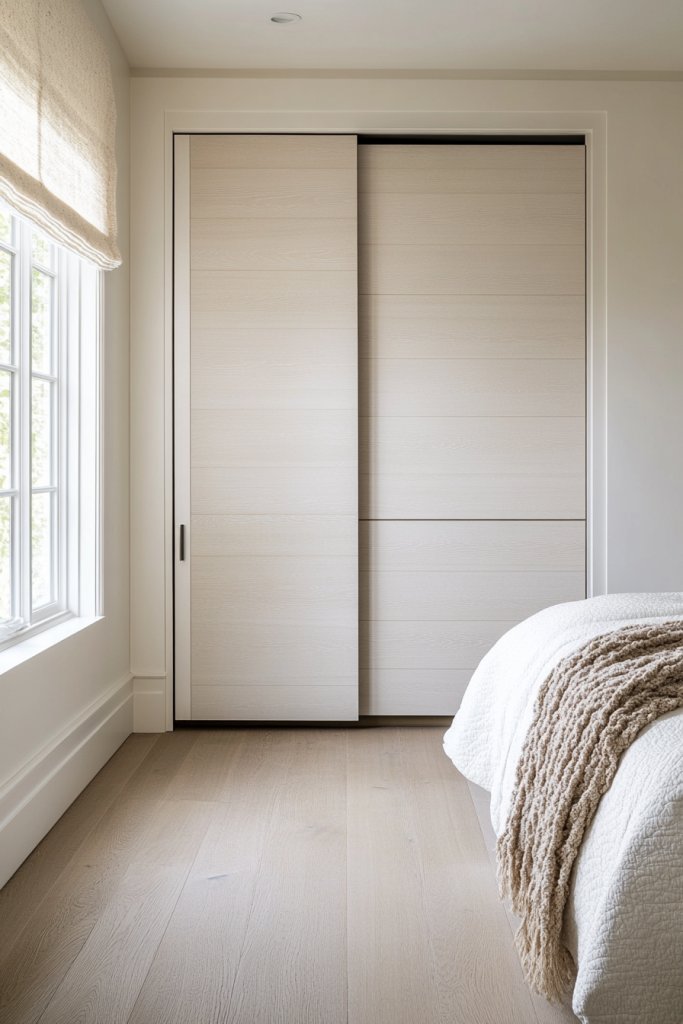
In small bedrooms, traditional swinging doors can take up valuable space, making the room feel cramped. Swapping them for sleek sliding wardrobes opens up the floor area, offering a streamlined, modern look while enhancing functionality.
Visualize a built-in wardrobe with sliding doors in a matte or glossy finish—perhaps in soft beige, cool slate, or crisp white—that glide effortlessly on concealed tracks. Behind these doors, you’ll find hanging space, shelves, and drawers neatly organized to maximize every inch.
The smooth surface reflects light, adding a subtle glow and creating an illusion of a larger space. When closed, the wardrobe blends seamlessly into the wall, giving your room a clean, minimalist appearance that feels expansive rather than cluttered.
To set one up, measure your available space carefully to select a wardrobe with sliding doors that fit perfectly. You can choose from pre-made units or customize a built-in solution with simple track systems available at most home improvement stores.
For a budget-friendly option, install sliding closet doors made from lightweight MDF or mirrored panels—mirrors especially help bounce light around the room. Keep the inside organized with hanging organizers and stackable bins to make the most of your new space-saving wardrobe.
8. Using Mirrors to Create the Illusion of a Larger Room
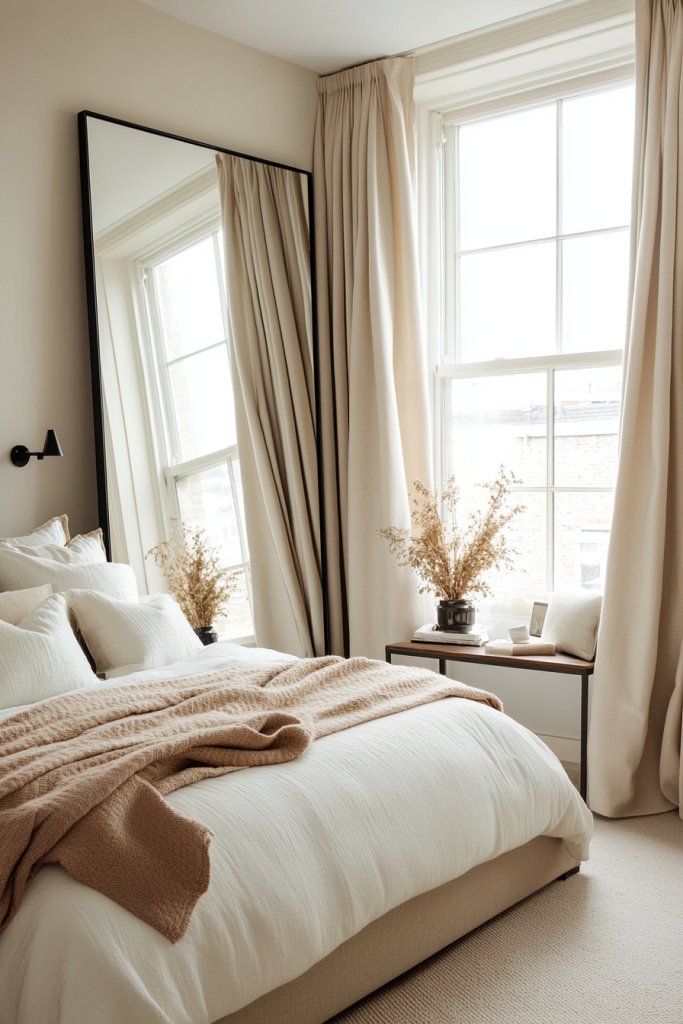
Mirrors are powerful tools in small bedroom design—they reflect light and give the impression of more space, instantly transforming your room into a brighter, airier retreat. Picture a large, full-length mirror leaning casually against a wall, or a series of smaller decorative mirrors arranged in an eye-catching pattern.
Choose frames in metallic finishes like brushed gold or matte black to add a touch of style. The reflective surfaces capture natural light from windows and bounce it around, making the room feel less confined.
Strategically placing a mirror opposite a window amplifies this effect, while a mirror behind the bed can visually expand the entire space. The overall result is a room that feels double its actual size, with a sophisticated, open vibe.
To incorporate this idea, select a mirror that suits your style—consider frameless designs for minimalism or ornate frames for a touch of elegance. Hang a large mirror on a wall that faces your main light source, or lean one against a wall for a casual, modern look.
You can also opt for mirror closet doors or wall-mounted geometric mirror panels for a decorative twist. Keep the surrounding area uncluttered to maximize the reflective effect, and enjoy the instant visual expansion this simple addition provides.
9. Minimalist Color Palettes to Make Small Spaces Feel Bigger
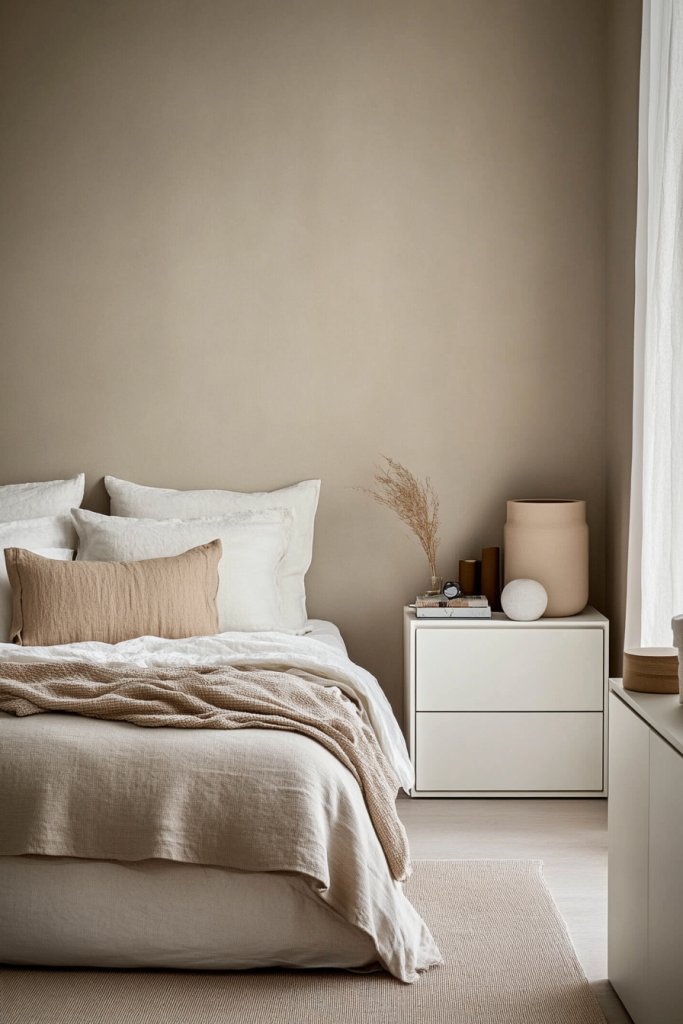
Color choice is crucial in small bedroom design—lighter, neutral tones can make the space feel open, calm, and more expansive. A minimalist palette creates a seamless, uncluttered look that visually enlarges your tiny sanctuary.
Envision a room painted in soft shades like warm ivory, pale gray, or muted beige, complemented by crisp white trim and simple textiles. These colors reflect more light, eliminating shadows and reducing visual clutter.
Incorporate subtle textures, like a cozy knit throw in a neutral tone or a plush rug in a matching hue, to add depth without overwhelming the senses. Keep accessories and decorative objects limited to a few well-chosen pieces in matching or complementary shades, ensuring the space remains calm and cohesive.
The overall effect is a serene, spacious atmosphere where everything feels harmonious and uncluttered. To achieve this, start with a neutral wall color—choose high-quality matte or eggshell finishes for a soft, diffused look.
Use white or light-colored furniture with clean lines to enhance the sense of space. Keep window treatments light and airy, like sheer curtains, to maximize natural light.
When adding textiles, select items in shades that blend seamlessly into the overall palette. This approach makes your small bedroom feel larger, brighter, and more inviting, transforming a tiny space into a tranquil retreat.
10. Creative Corner Solutions: Corner Desks and Shelving Units

Corners are often underutilized in small bedrooms, but with clever design, they can become functional zones for work, study, or storage. Corner desks and shelving units optimize space and add visual interest.
Picture a sleek corner desk in a neutral finish like white or natural wood, fitting snugly into the corner without blocking pathways. Above it, install corner shelves or a corner wall-mounted bookshelf in matching tones to hold books, decorative objects, or small plants.
This setup creates a dedicated workspace that doesn’t encroach on the main sleeping area. Add a comfy space-saving chair with a slim profile, and finish the look with a small task lamp and some decorative storage baskets.
The corner transforms into an organized, inviting nook, making the most of an otherwise overlooked space. To implement, measure your corner area carefully to select a suitable desk—options range from fold-down wall desks to compact L-shaped units.
Mount wall-mounted shelves or corner cubbies for extra storage, keeping the surface clear. Choose lightweight materials like MDF or plywood for DIY projects, or shop pre-made options for convenience.
Finish with decorative baskets or boxes for easy access and a tidy appearance. This approach smartly turns corner space into a valuable, multi-purpose zone that enhances your small bedroom’s functionality without sacrificing style.
11. Compact Seating: Ottoman Beds and Space-Conscious Chairs
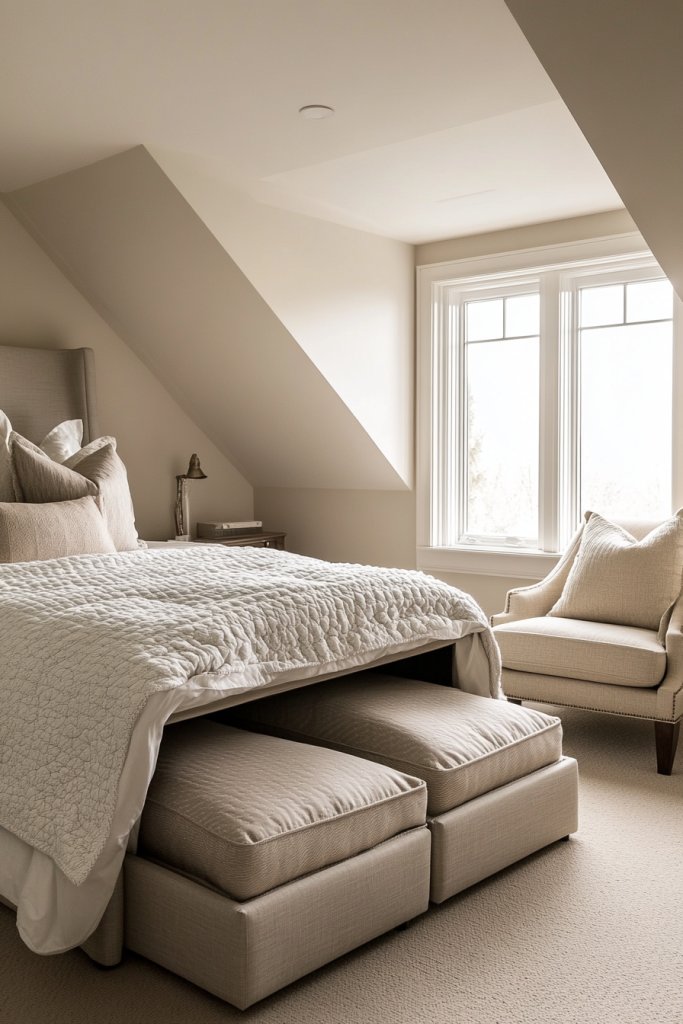
Creating a cozy yet functional small bedroom starts with smart seating options that don’t take up much space. Ottoman beds, which serve as both a bed and storage unit, are a perfect example—they offer a plush cushion top in a compact footprint, with hidden compartments underneath to store blankets, pillows, or seasonal clothing.
Space-conscious chairs, like foldable or stackable options, can be tucked away when not in use, making the room feel open and uncluttered. These versatile pieces enhance comfort without sacrificing precious floor space, especially in rooms with limited square footage.
Imagine a soft, neutral-toned Ottoman with a textured fabric cover—perhaps a woven boucle or linen blend—that doubles as a footrest or extra seating during visitors. Accompanying this, a sleek, minimalist chair with slim legs and a simple silhouette in muted colors like blush pink, charcoal, or matte black adds visual interest without overwhelming the room.
The textures—smooth wood, soft upholstery, or woven fibers—bring warmth and tactile appeal, making the space inviting. The overall aesthetic balances practicality with stylish touches, creating a room that feels both functional and cozy.
To implement this, start with a small Ottoman that includes internal storage—many affordable options are available at furniture stores or online. Choose a neutral or soft pastel fabric for a calming vibe.
For additional seating, opt for stackable or foldable chairs made of lightweight materials like metal or plastic, which can be easily stored away. Place these near the bed or in a corner, and keep them accessible but unobtrusive.
Cover the seating with a lightweight throw or cushion to add comfort and personality. With just a few simple pieces, your small bedroom can become a haven of comfort and practicality.
12. Floating Desks and Wall-Mounted Vanities for Open Floor Areas
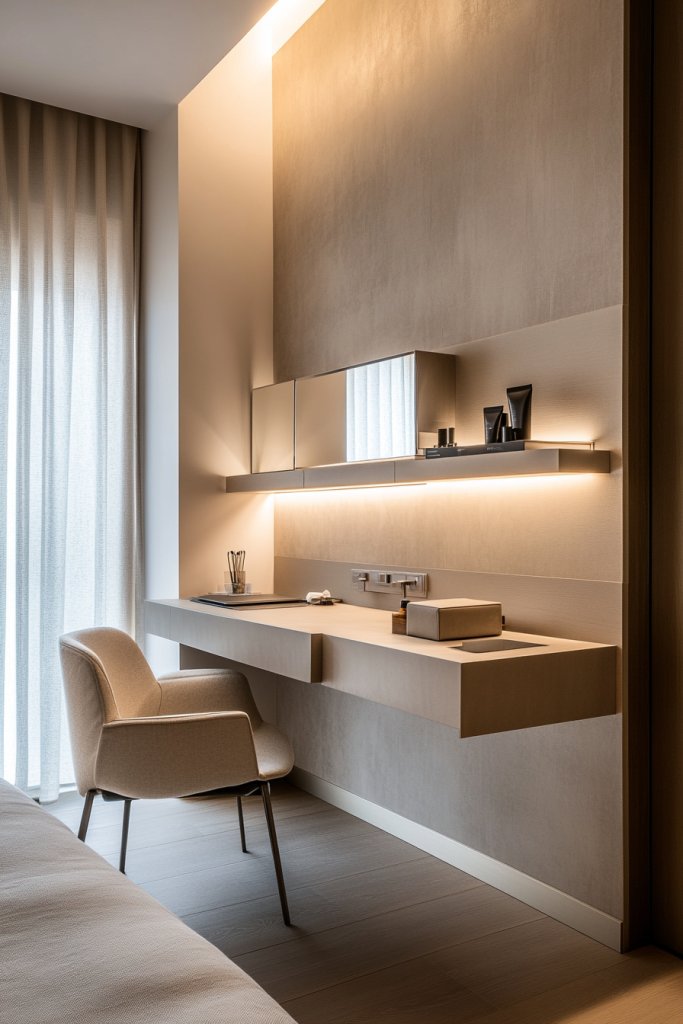
Maximizing floor space in a tiny bedroom means thinking vertically—floating desks and wall-mounted vanities are game-changers for creating a sleek, open feel. These fixtures attach directly to the wall, leaving the floor clear for easy movement and making the room appear larger.
A floating desk, in a natural wood finish or painted in a soft hue like mint or blush, provides a dedicated workspace or makeup station without cluttering the room. Similarly, wall-mounted vanities with slim profiles and integrated mirrors turn a small corner into a functional beauty zone that keeps surfaces free from bulky furniture.
Visualize a clean, minimalist setup: a floating desk with a smooth surface, perhaps in light oak or matte black, with a small decorative tray for essentials. Adjacent, a wall-mounted vanity with a round mirror framed in brass adds a touch of elegance and sophistication.
The open space underneath allows for easy cleaning and enhances the room’s airy feel. Incorporating LED strip lighting or wall sconces near these fixtures adds both task lighting and ambiance, making the space feel warm and inviting.
The overall effect is a streamlined, clutter-free environment that maximizes utility while maintaining a sense of openness. To recreate this look, select a sturdy floating desk or wall-mounted vanity made of wood, MDF, or metal—many affordable options are available online.
Mount it at a height that suits your needs, ensuring enough legroom or space for storage baskets underneath if desired. Pair it with a simple wall mirror or a lighted mirror for a practical touch.
Install wall sconces or LED strip lights above or beside the setup for optimal lighting. Keep the area tidy with minimal accessories—just a few essential items like a mirror, a small plant, or decorative jars—to maintain a sleek, modern aesthetic.
13. Hidden Storage in Headboards and Wall Panels
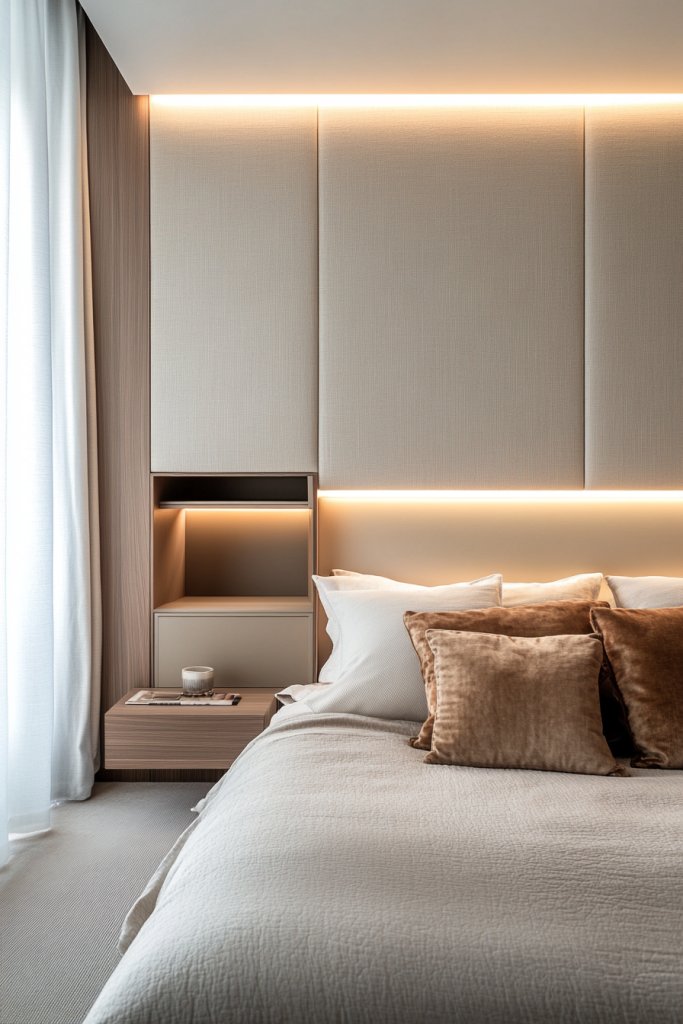
In small bedrooms, every inch of storage counts, and incorporating hidden compartments into headboards or wall panels is an innovative way to hide clutter. These built-in storage solutions are seamlessly integrated into furniture, providing space for bedding, books, or personal items without adding extra furniture pieces.
For example, a headboard with a lift-up lid or drawers behind a panel can serve as a practical storage nook. Alternatively, decorative wall panels with concealed compartments can hide away items while adding visual interest and texture to the room.
Picture a modern upholstered headboard in soft gray or beige, with a top panel that lifts up to reveal a hidden storage cavity. The interior might be lined with fabric to protect delicate items or serve as a quiet, cozy nook.
Or consider a sleek wooden wall panel with discreet sliding doors that open to reveal storage space behind. These features blend effortlessly into the room’s design, maintaining a clean aesthetic while offering clever space-saving solutions.
Textured materials like woven rattan, faux leather, or matte painted wood can add depth and style, creating a functional focal point. To implement, choose a headboard with built-in storage or modify an existing one with hinged lids or drawers—many furniture stores offer customizable options.
Alternatively, install wall panels with hidden compartments behind decorative wood or fabric coverings. Ensure the mechanisms are sturdy and easy to operate, and keep the interior organized with small baskets or dividers. This approach transforms your bed area into a dual-purpose space—comfortable and clutter-free—perfect for maximizing limited room without sacrificing style.
14. Compact Lighting Options: Wall Sconces and Clip-On Lamps
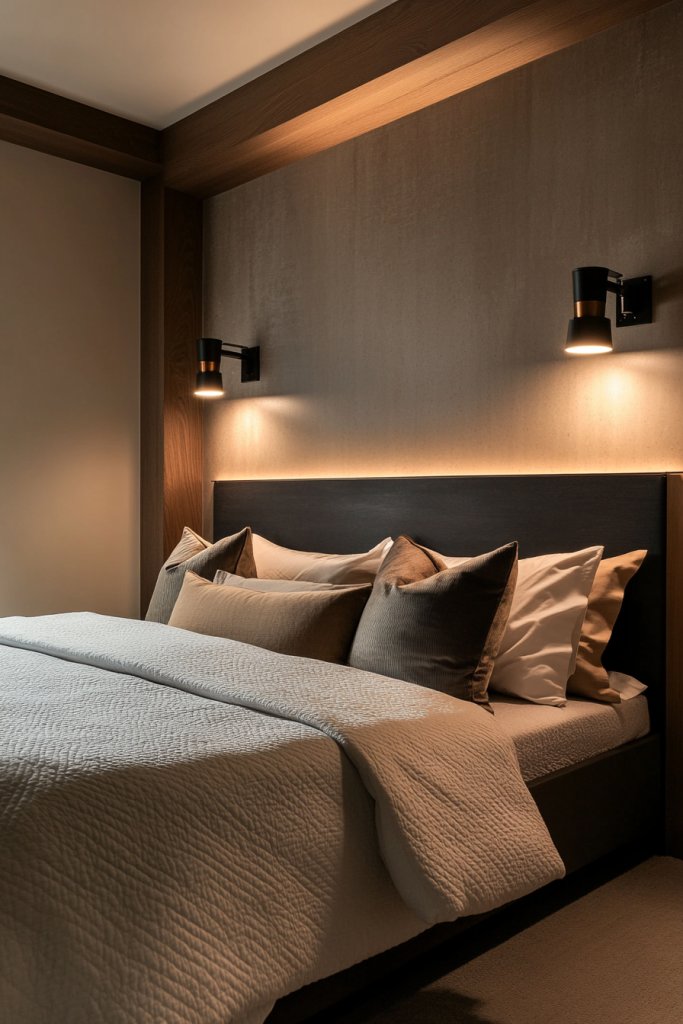
Lighting plays a crucial role in small bedroom design, and space-saving solutions like wall sconces and clip-on lamps are both stylish and practical. These fixtures eliminate the need for large bedside lamps or bulky ceiling lights, freeing up surface area and enhancing the room’s visual flow.
Wall sconces can be installed on either side of the bed, providing focused light for reading or ambiance, while clip-on lamps can be attached to shelves or headboards for flexible lighting options in tight spaces. Imagine sleek, minimalist wall sconces in matte black or brushed gold, mounted just above bedside tables or headboards.
Their compact design directs light downward or sideways, creating a cozy atmosphere without cluttering the room. Alternatively, clip-on lamps with adjustable arms, in neutral tones or metallic finishes, can be clipped onto shelves, beds, or wall brackets, offering versatile illumination that can be directed where needed.
These lighting choices add layers of warmth and functionality while maintaining a clutter-free aesthetic. To incorporate, select wall sconces with easy-to-install mounting hardware—many come with adjustable arms and dimmable bulbs for customizable ambiance.
For clip-on lamps, choose lightweight models with sturdy clips, and position them on existing furniture or wall-mounted shelves. Use LED bulbs for energy efficiency and a soft glow. This approach not only saves space but also adds a modern, streamlined look that complements various decor styles, making your small bedroom both bright and inviting.
15. Using Rugs and Textiles to Define Zones and Add Comfort

In small bedrooms, rugs and textiles are powerful tools for creating visual zones and adding tactile comfort. A well-chosen area rug can define the sleeping space, add warmth underfoot, and introduce color or pattern to enliven the room.
Soft throws, cushions, and bedding in cozy fabrics like chunky knits, velvet, or linen further enhance the inviting atmosphere. These textiles soften the room’s overall look, making it feel layered and thoughtfully styled, even in a compact setting.
Visualize a plush, neutral-toned rug with a subtle geometric pattern placed under the bed, extending a few inches beyond the edges to anchor the space. Layered with textured bedding—think a cozy cream duvet with a chunky knit throw in rust or deep green—the room feels warm and welcoming.
Small pillows with tactile fabrics like velvet or embroidered details add visual interest and comfort. The textiles not only define the sleeping zone but also make the room feel more expansive and harmonious.
To implement, select a rug that fits your space—measure the bed and leave enough room around it for a balanced look. Choose textiles that complement the room’s color palette and style, mixing textures for depth.
Layer your bedding with different fabrics for a cozy effect, and add decorative cushions or throws for personality. Regularly update or swap textiles seasonally to keep the space feeling fresh and inviting, turning your small bedroom into a cozy retreat that’s both functional and beautiful.
16. Incorporating Vertical Artwork and Decorative Elements to Enhance Visual Appeal
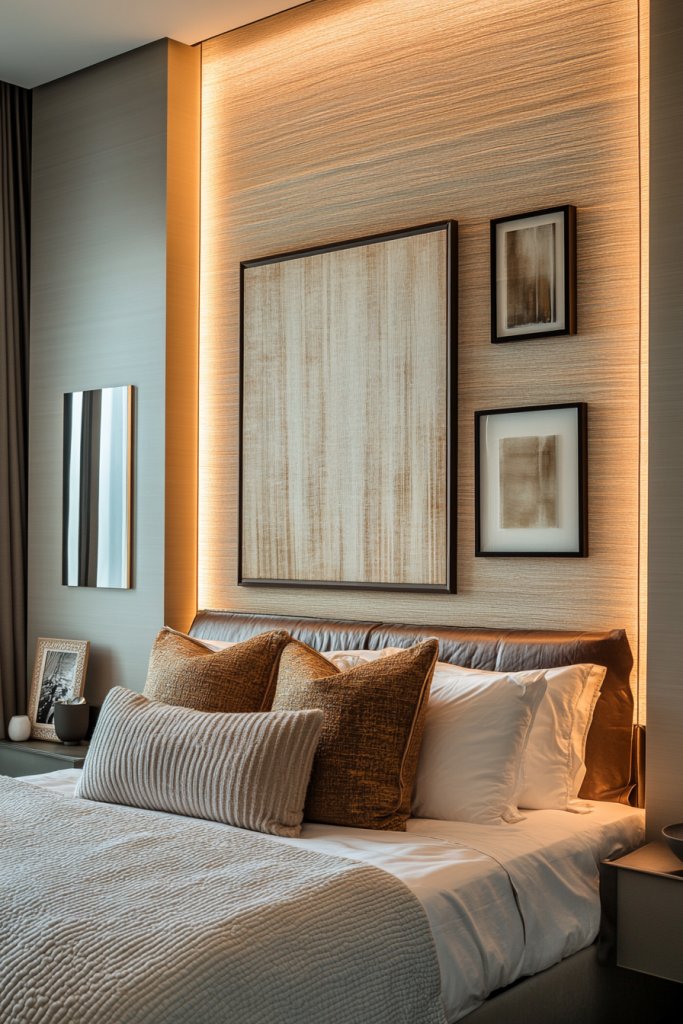
Adding vertical artwork and decorative elements is a clever way to elevate the look of a small bedroom without overwhelming the space. This approach draws the eye upward, creating a sense of height and openness.
Think of a tall, narrow gallery wall filled with framed photographs or minimalist prints, or a sleek, vertically oriented mirror that reflects light and makes the room feel larger. Incorporating textured wall hangings like woven tapestries or fabric panels can add warmth and tactile interest, while decorative shelves with small sculptures or ceramic vases introduce layers of visual depth.
These elements not only beautify the space but also serve as focal points that direct attention upward, giving the illusion of a bigger room. Imagine a wall painted in a soft, neutral tone—like warm beige or muted gray—serving as the perfect backdrop for elongated artwork in simple, clean frames.
The artwork might feature abstract designs, inspiring quotes, or scenic photography, all arranged in a vertical format to emphasize height. Combining different textures, such as a smooth, glossy mirror with rougher woven textiles or matte framed prints, adds richness to the visual experience.
The overall effect is a balanced mix of art and decor that complements the room’s compact size while making it feel more spacious and inviting. These elements subtly enhance the room’s personality without cluttering the limited space.
Getting started is simple: choose a focal wall and gather vertical artwork or decor pieces that speak to your style. For beginners, opt for affordable prints from online sources or create DIY art using washi tapes or fabric scraps.
Use slim, unobtrusive shelving to display decorative objects or small sculptures—preferably in lightweight materials like ceramics or wood. Hang larger pieces at eye level, ensuring they don’t overcrowd the wall, and keep accessories minimal but meaningful. By thoughtfully layering these vertical elements, your small bedroom will feel taller, more personalized, and visually appealing without sacrificing precious floor space.
17. Smart Layout Planning: Arranging Furniture for Optimal Space and Functionality

Thoughtful layout planning is key to transforming a small bedroom into a functional, comfortable retreat. The goal is to maximize every inch by arranging furniture strategically, so the space feels open and easy to navigate.
Start by measuring your room carefully and sketching a floor plan, considering the placement of windows and doors. Prioritize multifunctional pieces—like a bed with under-storage drawers or a fold-out desk—that serve dual purposes and save space.
Keep larger furniture against the walls to free up central floor space, making the room feel less cramped. Visualize the room’s flow: position the bed so it doesn’t block natural light sources or doorways, and place essential furniture like a nightstand or small dresser within easy reach without cluttering pathways.
If space allows, create zones—such as a cozy sleeping area and a compact workspace—using rugs or lighting to distinguish each zone. Maintain open sightlines by avoiding overcrowding, and consider using space-saving furniture like wall-mounted shelves or foldable chairs that can be tucked away when not in use.
This careful planning ensures the room feels cohesive, functional, and inviting. Implementing a smart layout begins with a clear plan: start by placing the largest pieces first, like the bed and wardrobe, then add smaller items.
Use online room planners or simple paper sketches to experiment with different arrangements. Consider alternatives like a wall-mounted fold-down desk or a compact, rolling chair that can be stowed when not in use.
Keep pathways clear and avoid placing furniture in front of windows to maximize natural light. By thoughtfully arranging your furniture, you’ll create a small bedroom that feels spacious, organized, and perfectly tailored to your daily needs, all while maintaining a welcoming atmosphere.
Conclusion
With a diverse array of space-saving strategies—from multi-functional furniture and vertical storage solutions to clever lighting and layout planning—there’s no limit to how you can transform a small bedroom into a stylish, functional sanctuary. By incorporating these innovative ideas, you can make the most of every inch and create a space that feels larger, more organized, and truly personalized.
Don’t hesitate to experiment and adapt these concepts to suit your unique style and needs—your perfect small bedroom is within reach. Start transforming your space today and enjoy the comfort of a beautifully functional retreat.
Leave a Reply